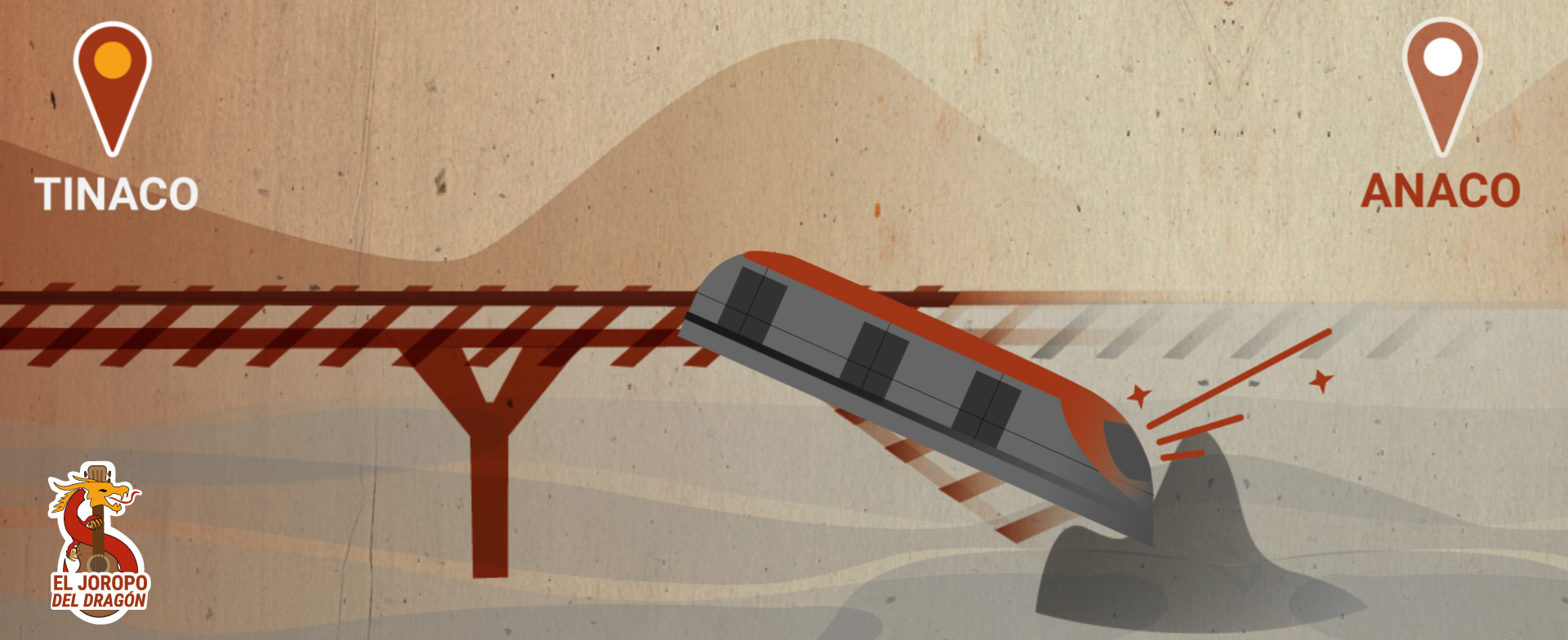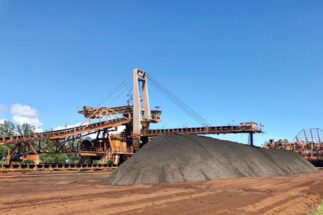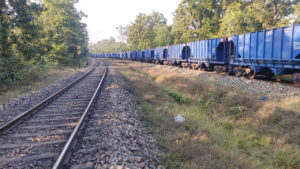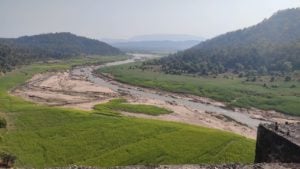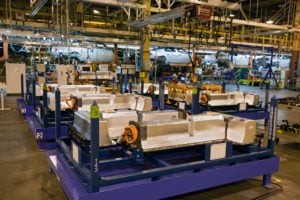In various parts of Venezuela, tunnels, rails and thick concrete columns with no obvious purpose stand as monuments to neglect. They look like testimonies left, with an indecipherable meaning, by giants or extraterrestrials.
But they are part of a 13,665-kilometre railway system on which trains should now be running, from one principal point of the country to another. At least that is what was foreseen in the 2006 National Socialist Plan for Railway Development, the realisation of which was partly guaranteed by the Venezuelan-Chinese Joint Fund (FCCV). The ambitious railway plan was initially designed by the Ministry of Infrastructure (Minfra), through the then State Railway Institute (IFE).
Fifteen years later, however, only 40 kilometres are in operation, barely 0.29% of the total planned. This is the Caracas-Charallave-Cúa section, which connects the Venezuelan capital with the commuter towns of the Valles del Tuy, in the southwest. Only isolated segments of the remainder of the system can be seen.
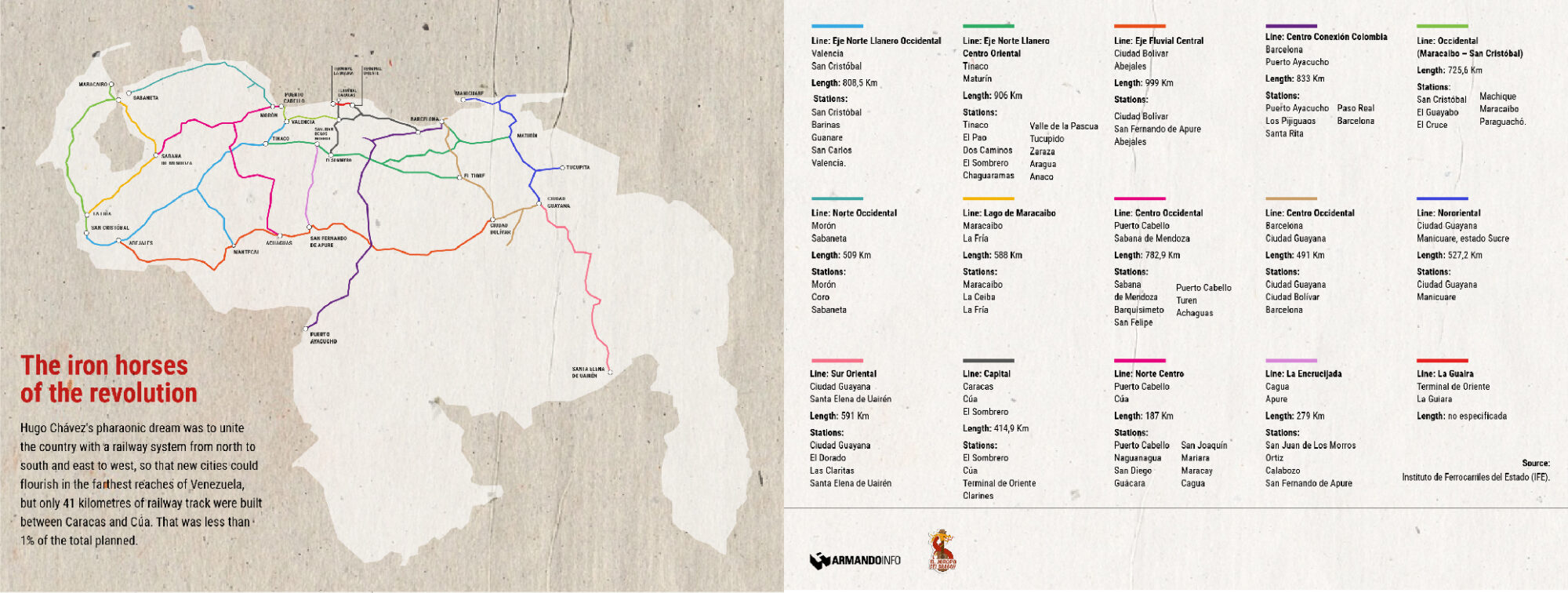
Some vestiges are what was intended to be China and Venzuela’s flagship Tinaco-Anaco rail project. The route sought to connect the country from west to east through the plains – from Cojedes state to Anzoátegui. In doing so, it would avoid the north-coastal axis, an area where the population, industry and, therefore, roads have traditionally been concentrated. It promised to encourage a new pole of development in the empty heart of Venezuela and aboard the “first bullet train in South America”, the possibility of shortening a 468-kilometre journey to just three hours.
Yet, promises never turned into reality as the company responsible for carrying out the work, the state-owned China Railway Engineering Corporation (CREC), got bogged down by disputes with Veneuelan labour, bureaucratic hurdles and language barriers. In the end, CREC withdrew from the works not only without completing them – it barely made 31% progress – but also without delivering the promised technology transfer.
China and Venezuela’s dream rail: Better quality and more speed
On 30 July 2009, China Railway Engineering Corporation (CREC) signed a contract with Venezuela’s State Railway Institute (IFE) for US$7.5 billion for the construction of the Tinaco-Anaco rail system. According to the document, the project would be financed through the Binational Fund, created in May 2008 during the visit to Venezuela of Hui Liangyu, then one of the Chinese government’s deputy prime ministers.
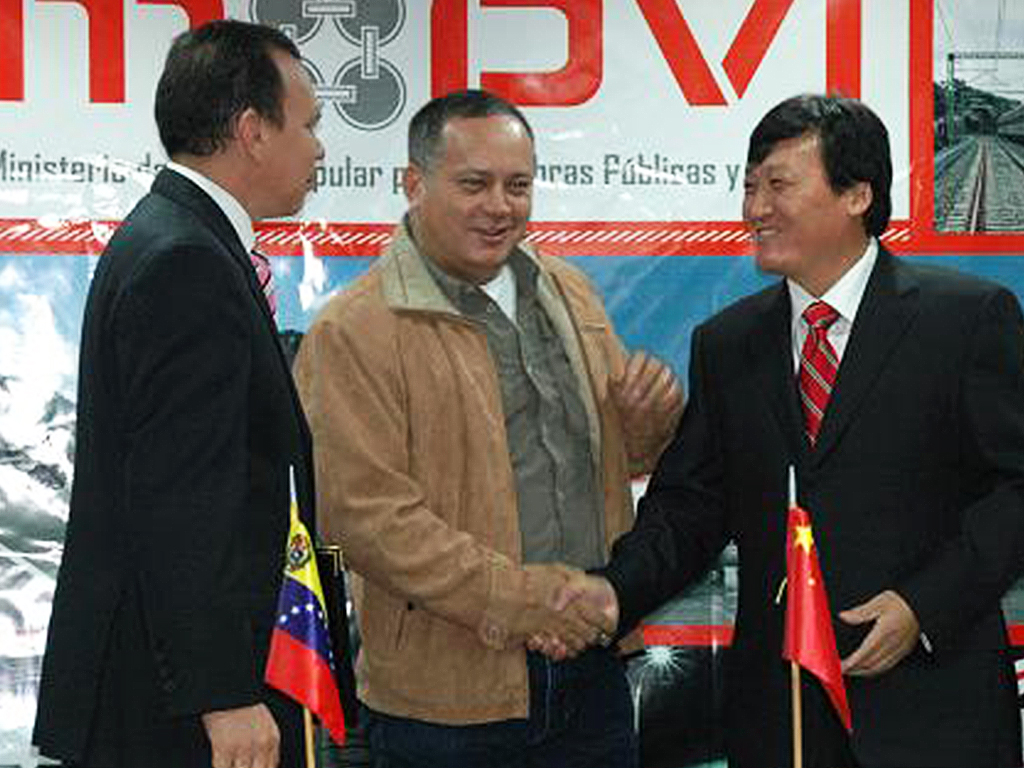
Armando.info has had access to the contract, along with others analysed by the Latin American Journalism Centre (Clip) for the series El joropo del dragón (Venezuela’s Dance with China), for which Diálogo Chino has provided additional reporting.
The agreement was signed by the then president of the Instituto de Ferrocarriles de Venezuela (IFE), Franklin Pérez, and Bai Zhongren, then vice-president of CREC. According to the agreement, the Chinese partner would register four mixed Chinese-Venezuelan capital companies in the country, thus transferring technology to Venezuela and contributing to a specialised workforce.
During the inauguration ceremony of the works on 22 March 2009, in the El Mamoncito sector of the Ortiz municipality in Guárico state, in the centre of Venezuela, Bai said: “We will finish this Tinaco-Anaco project with the best quality and the fastest speed. (…) We are going to make the complete technological transfer of engineering, construction and manufacturing to Venezuela. And we are going to negotiate with the Institute for the construction of sleepers, wagons and rails, to offer more jobs, to generate more employment opportunities for Venezuela”.
The project envisaged the construction of three plants or factories for sleepers – slabs of wood or cement that support the rails – rail welding and the assembly of switches at the Dos Caminos station (Guárico state), the contract says. There would also be a fourth wagon assembly plant at Chaguaramas station, in the same province.
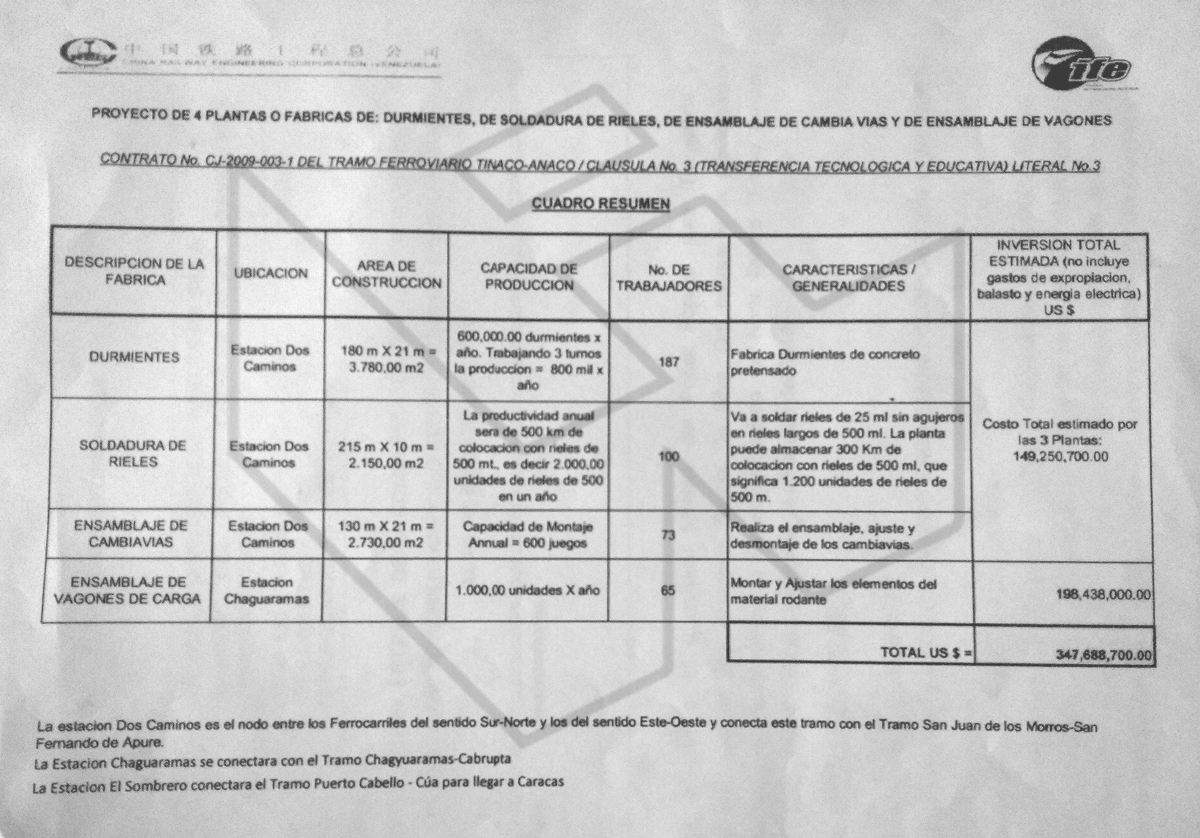
According to documents from the State Railway Institute, the total investment in the four plants was just over US$347.6 million. The factories were projected to produce 600,000 sleepers, 2,000 rails and assemble 1,000 freight cars per year.
At the time, spokespersons for Hugo Chávez’s government assured that the project would bring new development opportunities to a vast area stretching from the central to the eastern plains, its 1.3 million people and its economy sustained by agriculture and livestock and, to a lesser extent, tourism.
The freight and passenger train would pass through ten stations, including the towns of Tinaco and El Pao in Cojedes state; Dos Caminos, El Sombrero, Tucupido, Zaraza and Chaguaramas in Guárico state; Valle de la Pascua in Aragua state; and Aragua de Barcelona and Anaco, in Anzoátegui state.
Despite the lack of progress, China Railway Eryuan Engineering Group (CREEC), the design and engineering subsidiary of CREC responsible for determining the feasibility of the project, still has the Tinaco-Anaco project listed on its website as “the largest project undertaken by China in an overseas railway market”.
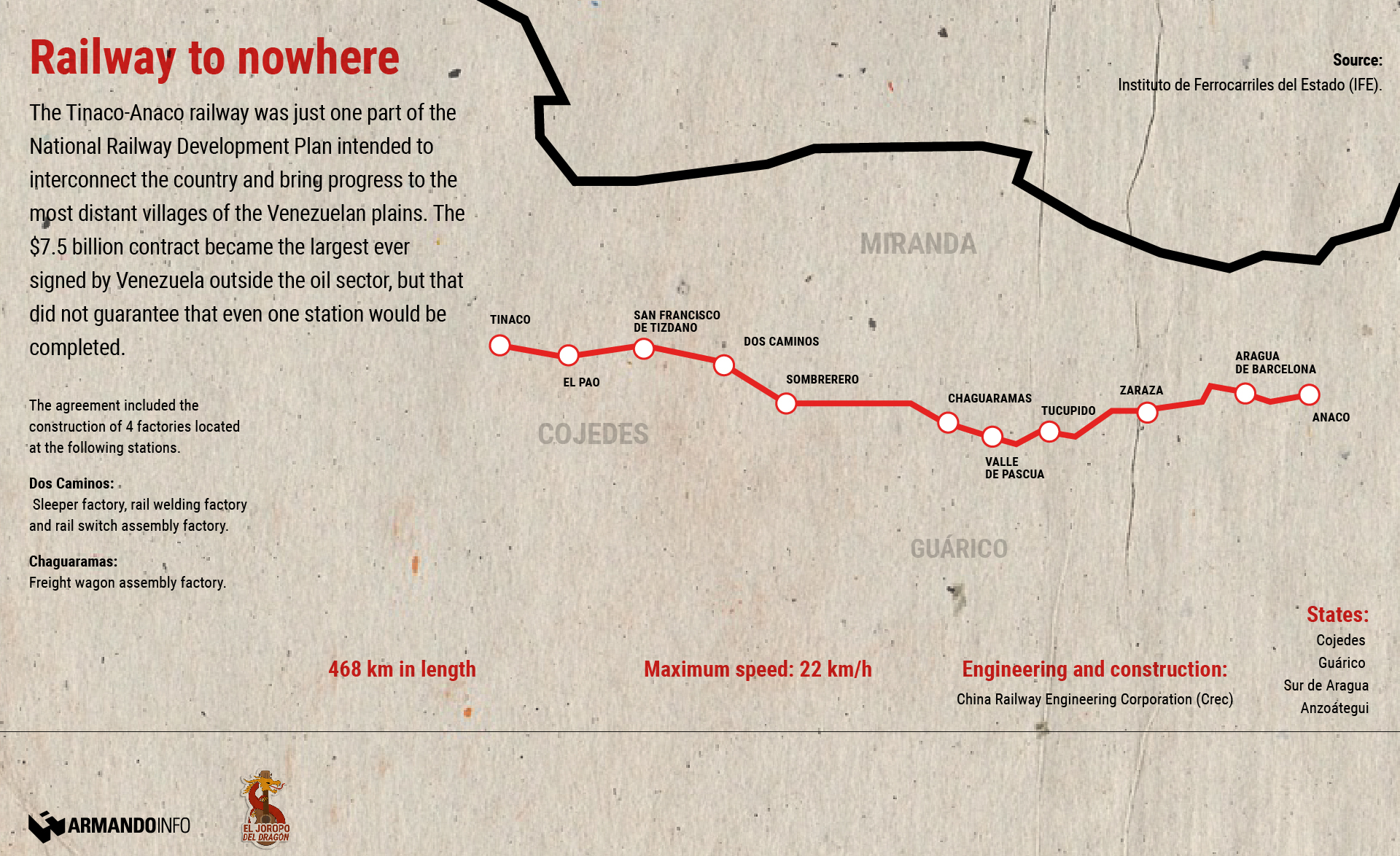
The plan envisaged that, upon completion, the Tinaco-Anaco Railway would connect with the now unfinished Ferrocarril del Centro, which would lead from Aragua state to Puerto Cabello, in Carabobo state; and with the Acarigua-Araure section, in Portuguesa state, which was to be extended to neighbouring Barinas state and Táchira, on the border with Colombia.
In state plans and in the mind of Comandante Chávez, a tangle of railways irrigated the whole country with progress. “It is the great railway of the northern plains axis”, the then president said jubilantly at the groundbreaking ceremony in El Mamoncito. The Chinese technology and money behind the project led Chávez, and to some extent CREEC, to count their chickens before they were hatched.
However, “once the Chinese left, people took everything they could sell”, says Ramón Figuera, a journalist and editor of El Tubazo Digital, a local media outlet. The looting was the rude awakening of a dream that could never materialise.
Paid for music that did not play
The work was partially paid for. In a status report presented in June 2010 by the Instituto de Ferrocarriles (IFE), a first disbursement of 10.66% of the total investment, equivalent to US$ 800 million, was made to begin work in 2009. In a communication issued on 9 July 2010 by Roger Caraballo, IFE’s general manager of railway development, and addressed to Gan Baixan, CREC’s executive president, he wrote that a second disbursement of US$675 million had been approved.
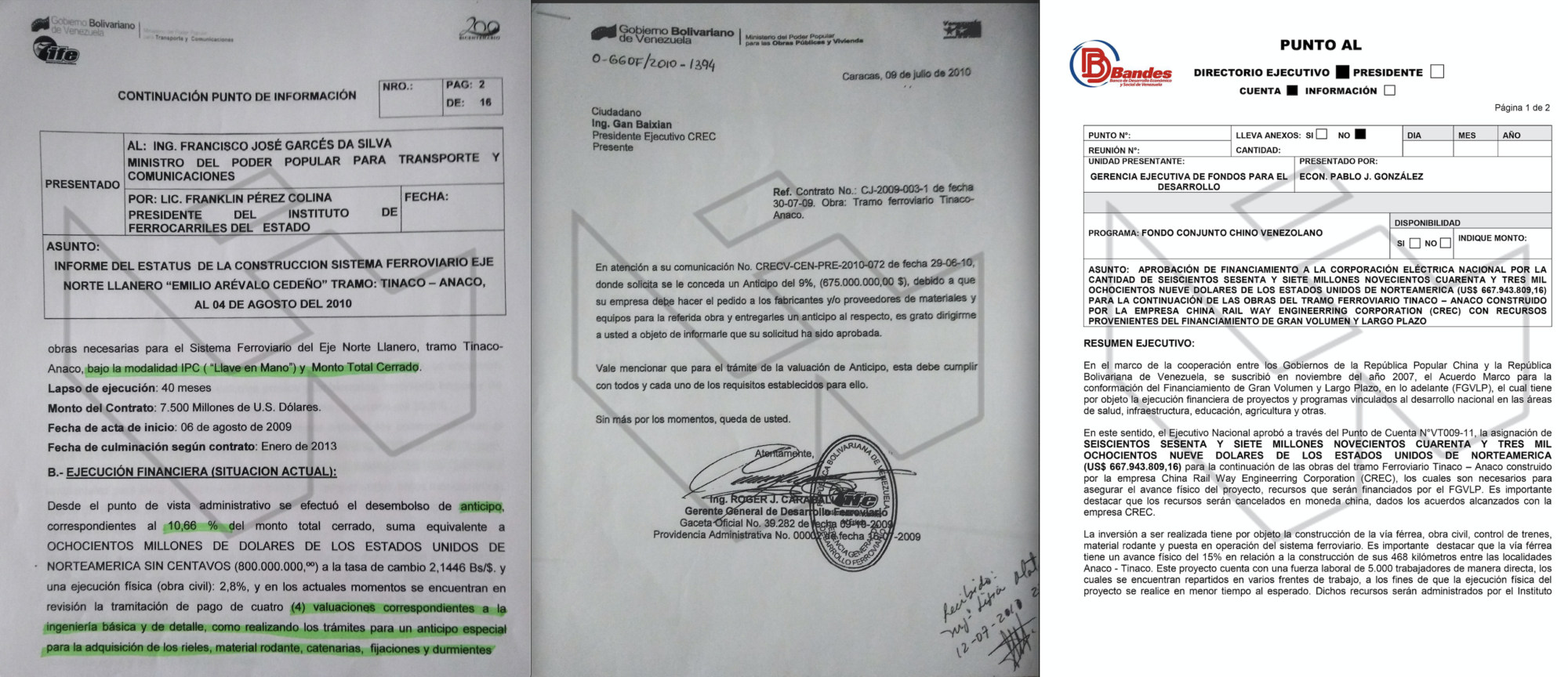
In 2011, the Executive Management of Development Funds at the Economic and Social Development Bank of Venezuela (Bandes) approved a third disbursement of US$667 million for the continuation of works on the Tinaco-Anaco Railway section. The allocation also appeared in the 2011 Annual Report and Accounts of the Ministry of Transport and Communications.
The 2012 report lists another disbursement of almost US$598 million for the ongoing work. The ministry wrote in its report that, while the financial execution of the project was fully on schedule during that period, only 5.6% of the project had progressed.
Despite the funds flowing in, in January 2011 the work was halted for the first time. Workers from different sections complained publicly that the previous month CREC had signed the severance cheques for almost all workers, arguing that the work had to be imminently suspended due to lack of resources.
Union leaders Hermis Ramírez, a local leader of the United Socialist Front of Workers of the Construction, Wood and Railway Systems Industry of Venezuela (FSUTC), and Jhon Vargas, of the National Union of Venezuelan Workers of the Construction Industry, Railway System and Related Industries (Sovica), said: “the company managers claimed that the national government gave them only US$800 million in 2009 to start the work and by December 2010 they had already spent US$1.2 billion dollars. $1.2 billion! They said that because of this they incurred financial losses and could not continue building the section”.

The then legal representative of CREC in Anaco, Tomás Aguilera, confirmed to workers that the operations were suspended, “not because of debt but because the talks between China and Venezuela had resumed to establish new guidelines”.
In an interview on the Televen channel in June 2013, IFE president Francisco Torrealba admitted that the Venezuelan government owed US$400 million to China. That year, the Ministry of Transport’s Annual Report and Accounts showed that the project received no resources in 2013 and that up to the previous year that only a third had been completed.
In 2014, the Ministry of Transport noted that among the obstacles to the progress of the works were variations in the prices of inputs and the “economic requirements of the projects above the real possibilities of financing in the year”. It added that “the execution of the works of the different sections has been affected due to the fact that the contractual commitments with several contractors have not been honoured”.
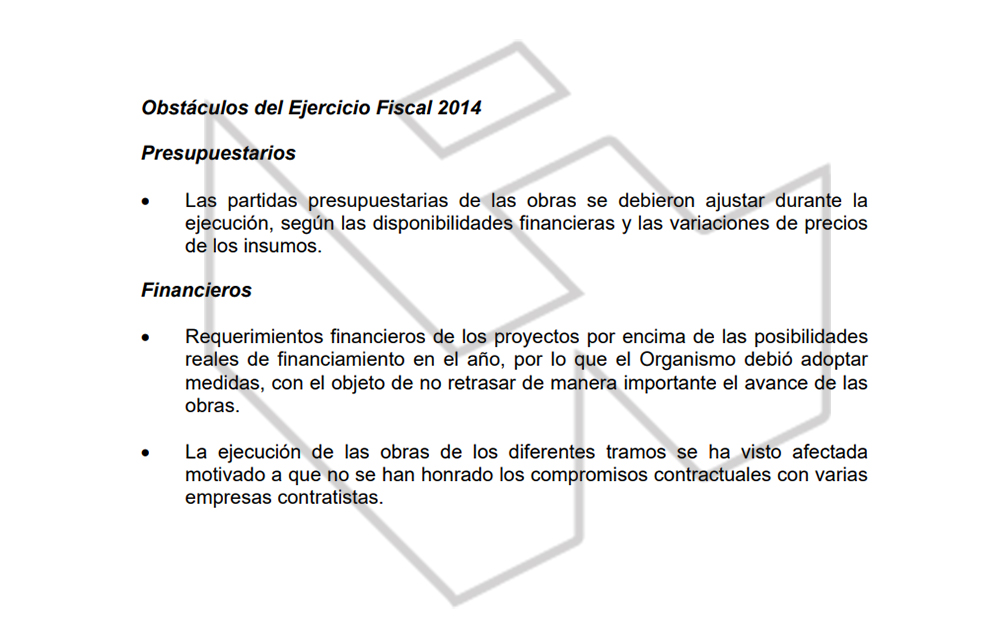
During a meeting of the Binational High-Level Joint Commission in Venezuela in June 2014, Gan Baixian, the president of China Railway International Group (CRIG), the arm of CREC in charge of overseas projects, called for “a prompt solution to the financial difficulties” of the Tinaco-Anaco railway project.
And that is as far as it went. Between 2011 and 2014, the project was intermittently paralysed and reactivated. In 2012, Francisco Solórzano, the then mayor of Anaco Anzoátegui state, announced that the construction of the railway in his municipality would restart in 2013, with completion set for 2016. He admitted in passing that “it has been at a slow pace”.
et, the local reinvigoration of the project never happened. When consulted for this report, Antonio Barreto Sira, an opposition leader and the governor of Anzoátegui state since 2017, said that the central government had not discussed the possible reactivation of the work, nor investigated the lost resources.
Five years after the definitive stoppage, the work lies abandoned and in some sections it is being dismantled, according to former National Assembly deputy Carlos Andrés Michelangeli, who toured the interior of the state of Anzoátegui in January 2021.
“The camp located in Anaco is abandoned, deteriorated and destroyed by vandalism,” he said.

Rafael Aponte, a regional member of the opposition Avanzada Progresista party in Cojedes state, said that the camps in the villages of El Pao and Tinaco were abandoned at least five years ago and that “even the floor tiles were taken from there, nothing was left”.
Both political spokespersons agree that the debacle accelerated in early 2015, when the Chinese directors of the project left quietly.
Reflecting on the failure of the railway, some Chinese commentators argued that the overtly political nature of China’s engagement with Venezuela precluded any sensible business decision-making and that the country lacked the necessary criteria to undertake a high-speed rail project.
Writing in the book Building Development for a New Era on Chinese infrastructure in Latin America, Haibin Niu, a researcher at the BRICS Policy Center, argued: “China’s experience with high-speed trains indicates the most viable routes are those that connect metropolitan areas and have a stable electricity supply. Those conditions did not exist in Venezuela.”
The overtly political nature of engagement with Venezuela precluded any sensible business decision-making
At the very least, Niu wrote, lessons would be learned: “The railway case in Venezuela taught Chinese companies that the better way to achieve successful overseas investment is to go through a traditional commercial process and follow financial common sense.”
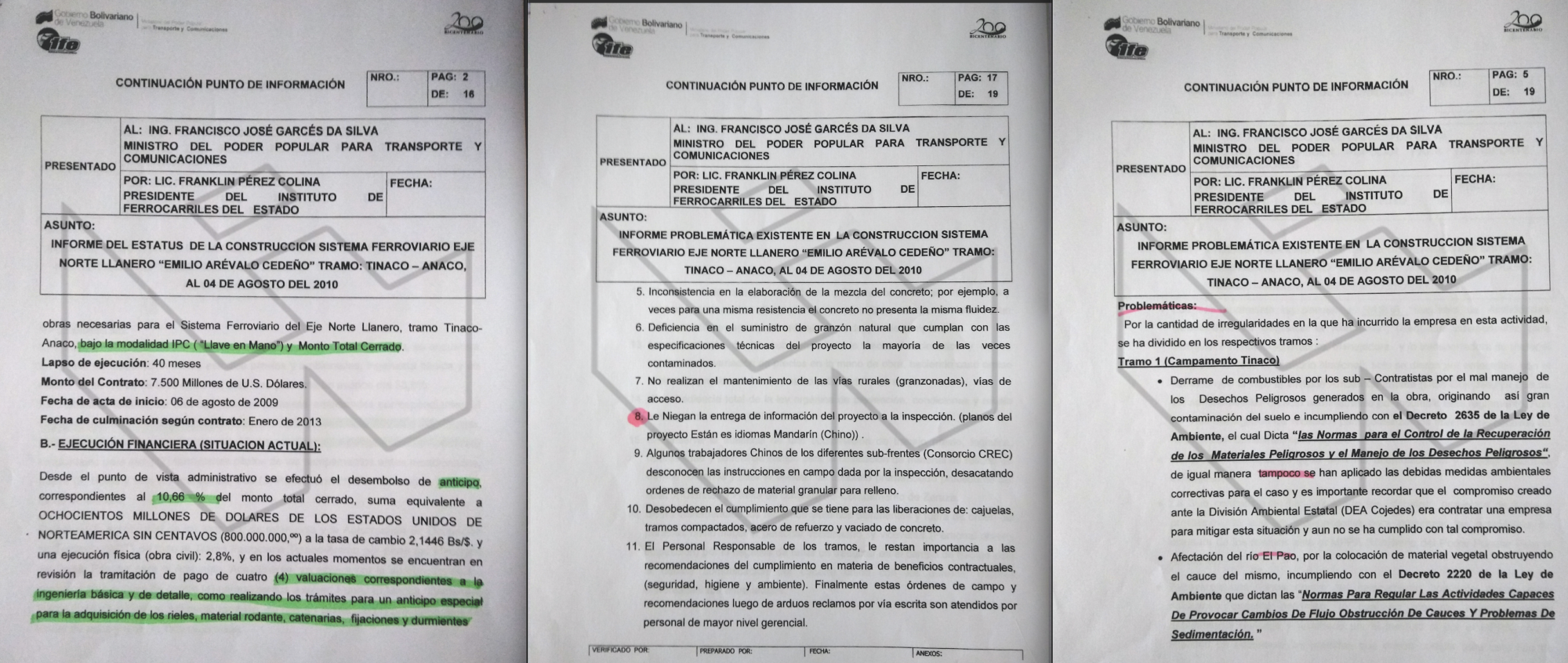
China’s rail in Venezuela: An inoperative Babel
Another problem the unfinished Tinaco-Anaco railway revealed was that national labour laws were suppressed and poor consideration was given by CREC to its environmental impact.
An internal report presented on 4 August 2010 by Franklin Pérez Colina, president of the Railway Institute, to then Minister of People’s Power for Transport and Communications at the time, Francisco Garcés, outlined these issues. In it, he explained there were “existing problems in the construction of the Emiliano Arévalo Cedeño northern plains axis railway system, Tinaco-Anaco section”.
Pérez Colina complained that CREC personnel did not adhere to Venezuelan construction regulations and refused to hire Venezuelan companies, which would have allowed the projects to be executed more expeditiously. Those that were subcontracted by the Chinese company, the report insisted, did not have the necessary equipment to carry out the work properly.
The agreement between CREC and IFE allowed the contracting of Chinese personnel for the works, something that became commonplace very early on in most binational projects. Often the contractual clauses of Sino-Venezuelan cooperation projects explicitly stipulated the suspension of Venezuelan labour regulations. This also enabled contractors to to employ and reminerate workers in line with Chinese customs and legislation.
“La problemática” by ArmandoInfo on Scribd
But this licence, according to Pérez Colina’s report, resulted in another Gordian knot. Communication did not flow well. There were no technical translators to facilitate understanding, neither in meetings to discuss specific projects, nor with workers in the field. Engineers were spoken to in Chinese and “plans, for example, were presented by CREC to Venezuelan staff in Mandarin”.
“There has been an increase in violent, defiant and out-of-order claims by Chinese personnel towards Venezuelan personnel due to the refusal to have a translator in the field to work for the proper communication between the Chinese foreman and the workers,” the report states.
In addition to this, complaints of non-compliance with contracts and labour standards proliferated during the works. On several occasions the workers went on strike to demand recognition of labour liabilities and wage improvements.
According to the same report, the Chinese personnel responsible for the different sections downplayed the importance of recommendations to comply with contractual benefits. “The salaries of the workers (workers and employees, both administrative and professional) in the different sections are different due to the lack of a tabulator. They are paid according to the criteria of the head of the camp (…) the contracting of the sub-companies is split up and they do not recognise the variation of prices in the workforce [sic], ignoring the presidential decree of the wage increase of 1 May”, Pérez Colina warned.
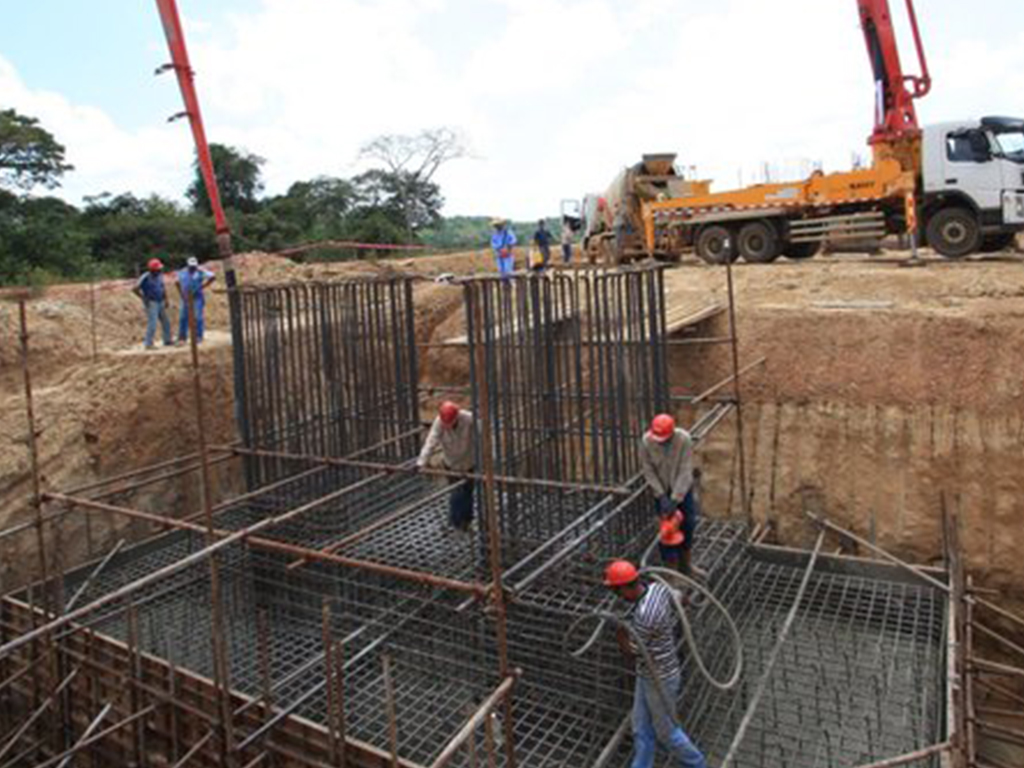
For their part, unions repeatedly denounced the company for violating labour laws, especially on the length of the working day and overtime. “China Railway Engineering Corporation (CREC) violates almost 70% of contractual benefits, does not recognise clinic service, pharmacy, travel time, weekend bonuses and food bonus adjustments,” workers told local media in August 2014.
They also complained that on several occasions they had sat down to talk with representatives of the Chinese contractor, who claimed that they could not provide these benefits because they only had to pay them for the working week and nothing else.
“This company is in breach of the collective bargaining agreement and the Organic Labour Law. We are tired of this repeated violation of workers’ rights. If they don’t catch up, this work will not continue and will be delayed much longer than it already is,” union leaders representing 200 workers on the section under construction between Aragua de Barcelona and Anaco.
Pollution too
Finally, a special section in the report addressed to the president of the Instituto de Ferrocarriles listed the environmental irregularities committed by CREC.
Sin permisos ambientales by ArmandoInfo on Scribd
Una investigación de la División Ambiental Estadal determinó que las empresas subcontratadas por la Crec no contaban con el Registro de Actividades Susceptibles de Degradar el Ambiente
In the camp installed in Tinaco, Cojedes state, the report said “the riverbed of the Pao river was affected by the placement of plant material that obstructed it, in violation of Decree 2220 of the Environmental Law, which dictates the rules for regulating activities capable of causing changes in flow, obstruction of the riverbed and sedimentation problems”. It also explained that “the poor management of hazardous waste generated at the construction site” led to a fuel spill, “causing soil contamination without the necessary corrective measures being applied”.
After an investigation in 2010, the State Environmental Division determined that the companies subcontracted by CREC did not have the Register of Activities Susceptible to Degrade the Environment, an indispensable requirement for any company responsible for generating, handling and transporting hazardous material in Venezuela. Part of the agreement established with the state-owned company to mitigate the impact was to hire another company to deal with the situation. However, at the time of the Railway Institute’s report, the commitment had not been fulfilled.
The Tiznado river in Guárico state was also affected because a ready-mix concrete plant was set up just 135 metres from the shore. From there, they dumped concrete aggregates that affected the Río Verde dam. The company’s subcontractors also deforested several areas without carrying out the required inventories and without due authorisation from the Ministry of the Environment. They felled valuable species such as oak, araguaney (Venezuela’s national tree), cedar and acapro, of the Tabebuia genus native to the Americas’ tropics and subtropics.
Non-compliance and complaints of violations of labour and environmental laws did not stop the Venezuelan government from contracting CREC
This is not the only Latin American project in which CREC’s design and planning arm has left question marks over its consideration of environmental risks. A subsidiary, China Railway Eryuan Engineering Group (CREEC), considered it feasible to build a proposed interoceanic railway between Peru and Brazil through sensitive Amazonian ecosystems and an indigenous reserve because of preferable topography.
One of its engineers told a Brazilian senate hearing: “They say the geology can be an obstacle. But the geology is even more complex in China, which has made Chinese railway construction technology more refined”.
The non-compliance of the Tinaco-Anaco railway and the various complaints of violations of labour and environmental laws did not stop the Venezuelan government from contracting a CREC-affiliated company again. In 2018, Venezuela’s executive vice president Delcy Rodríguez signed new agreements in China as part of the so-called Plan for Recovery, Growth and Economic Prosperity.
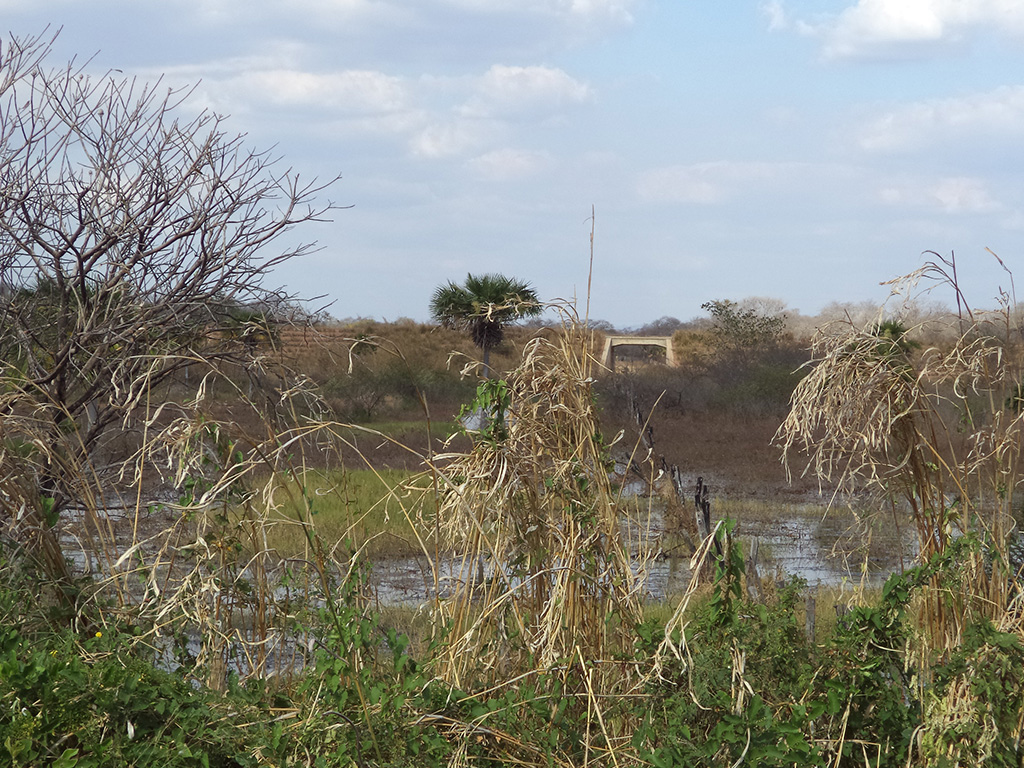
Among them, there is a contract with China Railway N° 10 Engineering Group Co Ltd, another subsidiary of CREC, to boost iron and gold production in Venezuela. Rodríguez was hosted in Beijing by the Chinese Ambassador to Venezuela, Li Baurong, and held meetings with Minister He Lifeng, chairman of the National Development and Reform Commission (NDRC), China’s top planning body. They pledged to “consolidate and expand cooperation between our countries,” Rodriguez tweeted on 10 September 2018.
Four days later, Venezuelan President Nicolás Maduro travelled to China to participate in the closing of the XVI Meeting of the China-Venezuela High-Level Joint Commission (CMAN), where 28 new agreements were signed on energy, mining, agriculture, industry, science and technology.
It is unclear whether this new contract includes any reference to the one that was abandoned, or why, after millions of dollars invested, only 41 kilometres of track have been laid.
When it all began in March 2009, the then Chinese ambassador in Caracas, Zhang Tuo, told Chavéz in Guárico that he wanted to “give thanks, deep thanks to the Venezuelan government, to the President, and also to the Minister of Infrastructure, for the trust placed in our company CREC because I can assure you that you have made the right decision”.
In time, he was proven very wrong.

*This investigation is based on a trove of documents obtained by Armando.info (Venezuela), which were processed and analysed in partnership with the Latin American Centre for Investigative Journalism (CLIP) and with additional reporting by Diálogo Chino.
